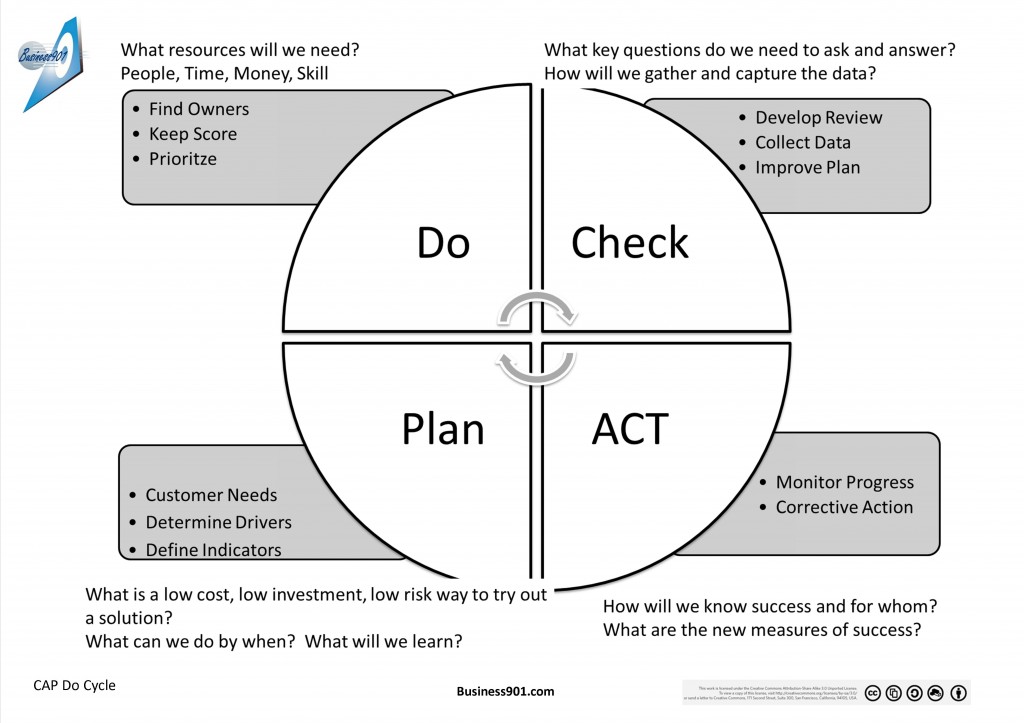CAPD Introduction: The Deming Cycle or The Plan-Do-Check-Act (PDCA) model is a proven framework for implementing continuous quality improvement. These four steps provide the framework for continuous improvement. The PDCA cycle basically starts with a plan and ends with an action in accordance with the information learned during the process.
Starting with Check is not a new phenomenon. Step-by-Step QFD taught me to use the CAPD process in design saying that Looking and Thinking corresponded to Checking and Acting. It is this process to compare actual work, or standard to our targets or objectives is the reason we start with Check. Without doing this often, we may change just for the sake of changing. Not knowing the appropriate reasons for changing. Brian Joiner in his book, Fourth Generation Management: The New Business Consciousness states it this way:
The temptation to “make changes” is great once we start asking people for improvement ideas. But it is a temptation we have to resist: in the beginning we simply don’t know what really is a good way to do a job. Are the documented standards best? The methods people are actually using? New ideas being recommended? Can we eliminate certain steps or inventory or inspection, or are they there for a reason?
To answer these questions, its best to use CAP-Do:
Check: Make sure we know why the work is being done. See if this purpose is clearly documented. Locate any existing documentation of methods. Compare actual practice with the documented methods. If there are no documented standards, compare different practices among the people doing the work.
The Basic Description of the Check-Act-Plan-Do (CAPD) Model:
Check: In the Check stage, one must check to determine where work is at this point and what are the existing standards. The standards and/or existing conditions must be checked. The conditions should be compared to the standards or perceptions. If a check detects a value different from the expected value then a search for the cause of the difference should be initiated.
Summary of the Check Stage:
- Analyze the data.
- Compare data to perceptions.
- Summarize what was learned.
- Proceed with results.
Act: If the Action stage determines that the work is not being performed according to expectations or targets or those results are not what were anticipated, measures must be devised for appropriate action and you go back thru the next project.
Summary of the Act Stage:
- Standardize changes learned into the implementation.
- Complete the data analysis and verify to the target.
- Establish the process/controls needed to monitor.
Plan: The Plan stage should take up 50% of your efforts and it is where you define the customer objectives or the problem statement and determine the conditions and methods required to achieve the objectives. It is imperative that you clearly describe the customer need you must fulfill and the goals and policies required to achieve the objectives at this stage. A specific target should be documented numerically, if possible, and the procedures and conditions for the means and methods to achieve the target must be described.
Summary of the Plan Stage:
- State the objective of the change.
- Define causes within the current state that keep the system from achieving the objective.
- Determine baseline measurements of the existing process.
- Understand the causes that make up the problem.
- Decide what needs to change to eliminate the problem.
- Develop a plan to carry out the change
Do: In the Do stage, conditions are created and the necessary training or additional support to execute the plan is implemented. It is important that the sales/marketing teams completely understand the objectives and the plan and are in agreement with the procedures needed to fulfill the plan. The work is then performed according to these procedures.
Summary of the Do Stage:
- Implement the change in a trial form.
- Adjust and modify where needed.
- Document what you have learned, both expected and unexpected.
Theory U: Leading from the Future as It Emerges, when applied to the CAP-Do cycle, does a remarkable job of explaining the shift required from internal thinking as an organization and moving to collective/external thinking. Scharmer calls this link the field structure of attention. What I like about the process is that it does not require you to throw away the old but by simply applying CAP-Do. In the Check/Plan stages, we are able to reflect and adjust our internal thinking and provides incremental improvement to our external world of the Act/Do stages. A complete blog post on the subject, Lean Marketing Conversation – CAP Do.
If you are looking for a starting point in Lean in sales and marketing, you could do worse than purchasing the Marketing with Lean Book Series and receiving access to the online Lean Sales and Marketing Training at no additional charge.

